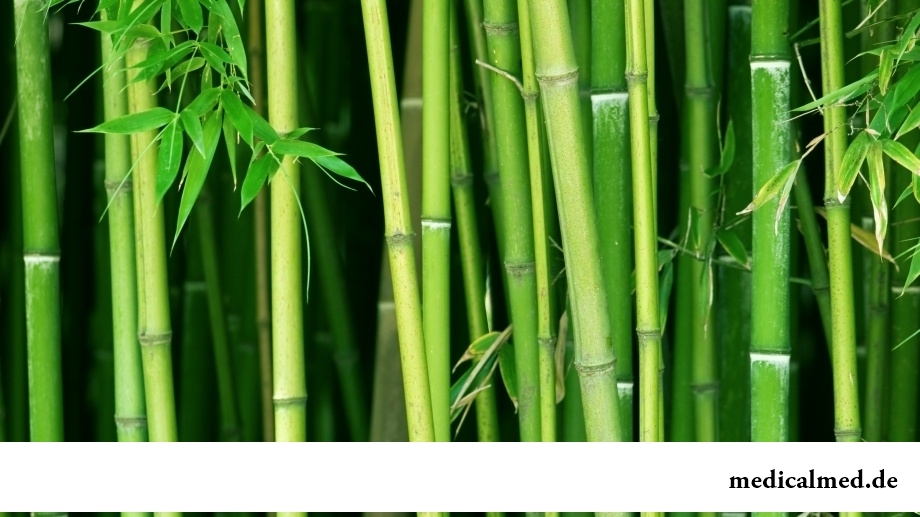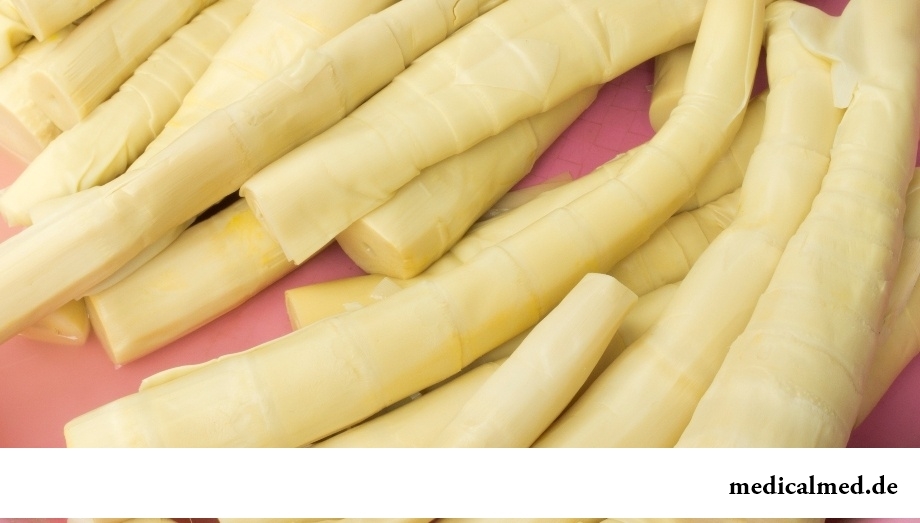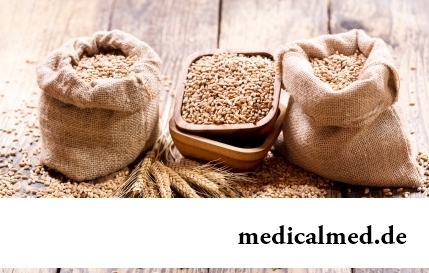





Bamboo
Description of a bamboo
Bamboo – a durable evergreen macrotherm from family of Cereals which homeland East Asia is considered.

The bamboo differs in a knotty golden and straw stalk with numerous leaves on a top. As a rule, it reaches in height from 25 to 40 meters and is the highest grass among all representatives of this family (wheat, corn and rye). At the same time the bamboo differs in very high speed of growth and some of its types grow at from 40 to 100 cm a day.
Within three years the young trunk stiffens. Bamboo trunks widely use for construction and as finishing material, make musical instruments of it and apply to production of paper.
The bamboo is distinguished by surprising properties – he is not afraid of either moisture, or the sun, or temperature differences. In the east of it consider a symbol of unrestrained force and energy as its sprouts with ease punch even a stone. Buddhists to it treat as the sacred plant representing longevity, the spiritual truth, constancy, grace, long friendship and the blossoming old age.
Structure of a bamboo
The bamboo contains 90% of water in the structure. It is rich with protein – on average from 1,49 to 4,04 g in 100 g of fresh escapes. Besides, eight main irreplaceable amino acids are its part.
In 100 g of escapes of a bamboo contains:
- 90,86 g of water;
- 2,65 g of proteins;
- 0,49 g of fats;
- 0,58 g of cellulose;
- 0,88 g of ashes.
The bamboo has rich vitamin structure. Its escapes contain vitamins A, B6, E, thiamin, Niacinum, Riboflavinum, folic and pantothenic acids. Also they are rich with minerals among which there is a calcium, phosphorus, magnesium, potassium, manganese, sodium, zinc, copper, selenium and iron.
Caloric content of a bamboo makes 20 kcal on 100 g of escapes.
Useful properties of a bamboo
Draws of a bamboo not only are tasty, but also are rich with nutrients. They enter the five of the most popular useful products in the world.
The main properties of a bamboo were written down in the ancient pharmaceutical text of times of a dynasty of Min (1368-1644): "He is cool, sweet, non-toxic, satisfies thirst, improves blood circulation, adds Qi's energy and can daily be used".
In the Asian countries the antiinflammatory and fortifying properties of a bamboo caused by existence of a strong antiseptic agent in its fibers often are used at colds and a SARS, and also at allergies and asthma.
The bamboo also belongs to the few plants differing in a large amount of silicon acid, which:
- Promotes strengthening of hair and nails;
- Well influences skin;
- Renders the calming effect at depressions.
The bamboo is effective at a peptic ulcer, disturbances of digestion and diarrhea. In the Asian countries it is also applied at treatment of such diseases as jaundice, tuberculosis, fever and dysentery.
Extract of a bamboo strengthens walls of vessels, improves blood supply of fabrics, reduces permeability of capillaries and increases their elasticity and a tone.
In the medical purposes apply not only escapes of a bamboo, but also other parts of this surprising plant:
- Roots of a bamboo use as fortifying means;
- The leaves of a bamboo having febrifugal and expectorant properties are considered as good cough medicine;
- Bamboo juice is used as means at an apoplexy and epilepsy.
Advantage of escapes of a bamboo for health
Escapes of a bamboo belong rather to exotic food as most widely they are used in the countries of Asia. However useful properties of a bamboo gradually find the admirers and in the western countries.
The bamboo promotes gradual loss of weight. Thanks to the balanced food stock it is considered ideal food for those who want to lose weight, without hungering at the same time constant. The food fibers entering in a large number a bamboo are necessary for digestion and improvement of a perilstatika of intestines. To grow thin it is recommended to eat draws for dinner quicker. Low caloric content of a bamboo and low content of carbohydrates allow to apply it as a part of various vegetable diets.
The vitamins, minerals and antioxidants which are a part of escapes of a bamboo promote immunity strengthening.
According to many researches conducted in India and the Asian countries the advantage of a bamboo for prevention of heart diseases as it promotes cholesterol dissolution is proved. Thanks to the insignificant content of fats and low caloric content the bamboo also well influences also function of intestines.
Many researches confirmed the antiinflammatory and anesthetizing properties of a bamboo that allows to use it outwardly at treatment of wounds and ulcers.
Use of a bamboo
Broth from escapes of a bamboo is applied in the Asian countries to treatment of respiratory diseases. As a rule, for receiving broth escapes should be boiled twice, at first 5, then 10 minutes. The received broth can be accepted with honey.
The traditional Chinese medicine considers that escapes of a bamboo have rather rare property – to have a promoting effect on uterus muscles. Also bamboo leaves apply at a gastric disturbance and as helminthic.
Escapes of a bamboo apply in cookery to production of various dishes. As a rule, they are previously cooked then eat with oil and soy sauce. Also they can be added to soups, sauces, a pickles and salads.

Fresh escapes of a bamboo remain up to two weeks in the cool place and far from a sunlight. The wrong storage can result in bitter taste. Longer to keep useful properties of a bamboo, it is preserved, as a rule.
Japan also eats bamboo seeds which bear a faint resemblance to oats.
Contraindications and harm of a bamboo
Any contraindications to use of a bamboo in food are not recorded. However at preparation of dishes with escapes of a bamboo it is necessary to consider that draws contain a poisonous cyanogenetic glycoside which, however, quickly collapses in the course of culinary processing.
Each person has not only unique fingerprints, but also language.

People know that thermal sources have salutary force long ago. Treatment by natural waters is one and...
Section: Articles about health
In consciousness of our many compatriots idea that folk remedies if are no more effective, than medicinal "chemistry" strongly took roots, then are precisely less harmful. Unfortunately, it is not always fair: some receptions treating...
Section: Articles about health
Sugar - the digestible refined product which is not of special value for an organism of the modern person. The use of sugar in food is based rather on the psychological dependence caused by desire to indulge itself with something tasty, and further and the biological, caused need of an organism for glucose as a result of big emissions of insulin in blood. Such circulation of insulin and glucose with continuous increase in portions of sugar is rather offensive and can become the reason for a narusha...
Section: Articles about health
The immunity role in growth of the child is invaluable. The proteins-immunoglobulins produced by immune system preserve the child against diseases...
Section: Articles about health
Herpes simplex of the first type (the infectious disease which is shown periodic bubble rashes on lips is called) – one of the most widespread illnesses. Statistically, only 5% of inhabitants of our planet are unreceptive to its activator, and...
Section: Articles about health
Life of the modern woman is very difficult. Opportunities to realize itself are wide: it not only education and career, but also the most various hobbies from sport before needlework. It is not less important to build private life, paying an attention maximum to children, the husband, parents, friends. For all these affairs there is catastrophically not enough time therefore each of us tries to cut down as far as possible its expenses on necessary, but not the most fascinating housework. With it we are successfully helped by means...
Section: Articles about health
An eye of the person daily experiences considerable strain. The problem of preservation of sight is for many years directly connected with a question снабж...
Section: Articles about health
Neurosis is called pathology of a nervous system at which deviations in functioning of the highest nervous processes are observed. Most often - owing to yet not strengthened mentality - children are subject to neurosises. Premises to emergence of such disturbances can become нез...
Section: Articles about health
Shops of household appliances offer us the huge choice of various devices for the house. Whether there are among this abundance devices which not only facilitate house work, but also help to keep health of the person? Of course, and we will tell about them today....
Section: Articles about health
All of us, unfortunately, should face flu nearly an every year. It would seem, so frequent disease has to be study...
Section: Articles about health
The healthy nutrition is the invariable principle of health and good health for long years of the woman. Nevertheless, in a diet at each stage of life there are the features allowing to support an organism by those substances which are most necessary...
Section: Articles about health
More than a half of the married couples which faced prostatitis – leave. The new broadcast "Female View of Prostatitis" will help to learn – whether you have or your relatives problems....
Section: Articles about health
Among a set of the perfumery and cosmetic goods which are released today the special group is made by the means containing anti-bacterial...
Section: Articles about health
Statistically, in Russia about 34% of citizens smoke. Most of consumers of tobacco has problems with health sooner or later. Not only smokers, but also their relatives suffer. Besides, cigarettes are expensive, and need of their acquisition heavy bry...
Section: Articles about health
Summer in the heat. Many are going to spend vacation abroad. Travelers the tender seas, rest on beaches wait, for sightseeing, campaigns on natural and cultural reserves. But, unfortunately, on vacation also problems with health can wait for us. On a foreign trip it is possible to face also diseases which not only will spoil long-awaited issue, but also will force to be treated within long months after its termination. To be insured completely from troubles of it a sort...
Section: Articles about health
The words "disease" and "patient" not without reason come from one root – "pain". As a rule, symptoms of illnesses thoroughly spoil the patient...
Section: Articles about health
The advantage of swimming for the person is so high that this sport is not only the most popular, but also is widely applied in medicine and rehabilitation processes. If you look for for yourself the occupation allowing pleasantly and to spend time, then swimming with advantage...
Section: Slideshow
Work of a brain is extremely complex and in many respects is not studied yet. It is confirmed also by the features of thought processes which are shown when the person sleeps. Let's tell about some of them....
Section: Articles about health
The winter swimming in open reservoirs called in our country by "winter swimming" – officially recognized sport and one of the ek...
Section: Articles about health
Popular joke that there are no healthy people, and is nedoobsledovanny, most of us considers an honest truth, continually it is necessary to hear that all of us are sick hardly from a school bench. It is hard to say, whether so it actually because...
Section: Articles about health
Hemorrhoids – extremely widespread disease. Periodically arising inflammations and bleeding of hemorrhoidal nodes cause serious discomfort to nearly fifteen percent of adults. Meanwhile, having a clear idea of the reasons of an exacerbation of an illness and following rules of precaution, it is possible to reduce substantially sharpness of unpleasant feelings and to reduce progressing of a disease....
Section: Articles about health
The metabolism at each person proceeds in own way. However dependence between the speed of this process and disposal from superfluous in...
Section: Articles about health
There is an opinion that at low temperatures safety of products is ensured longer and better thanks to what the refrigerator is considered the most suitable place for storage of food. In most cases it is fair, however there is a number of products, for a kotor...
Section: Articles about health
EKO, or extracorporal fertilization - a method of treatment of infertility which became the reason of a set of broken-down copies in due time accused the people working on its creation neither more nor less of rivalry good luck. Already very few people deny the right of a method for existence, and to surprise nobody with "children from a test tube". And nevertheless, a certain magic in the procedure of artificial fertilization is, process of origin of new life is always a secret, and even it р now...
Section: Articles about health
The concept "gluten" (differently, a gluten) combines group of the proteins which are a part of rye, barley and wheat. For most of people упот...
Section: Articles about health
Each person has easy indispositions which he transfers "standing", trying not to ask for medical care. Arguments at the same time are adduced same: "it is a trifle, itself will pass", "I have too many important issues", "there are no wish to spend time on...
Section: Articles about health
High temperature - a frequent symptom of such widespread diseases as a SARS, quinsy, pneumonia, etc. To reduce heat, having facilitated a condition of the patient, doctors recommend to accept antipyretics, however their use is not always possible. Too frequent use of these drugs can lead to allergic reactions, and also overdose, causing poisoning. It happens also that there are no antipyretics simply in the house. In these situations it is pertinent to use it...
Section: Articles about health
